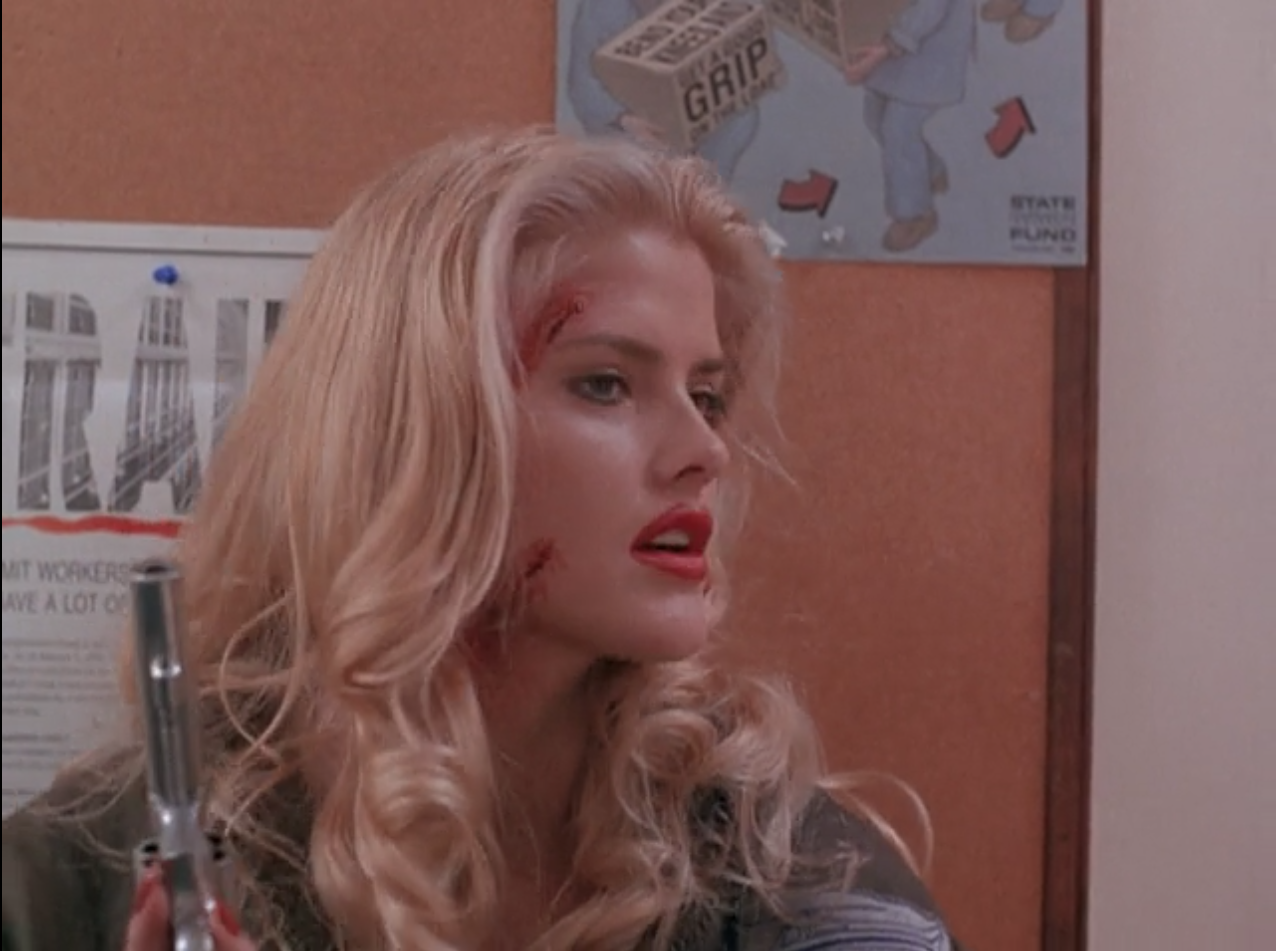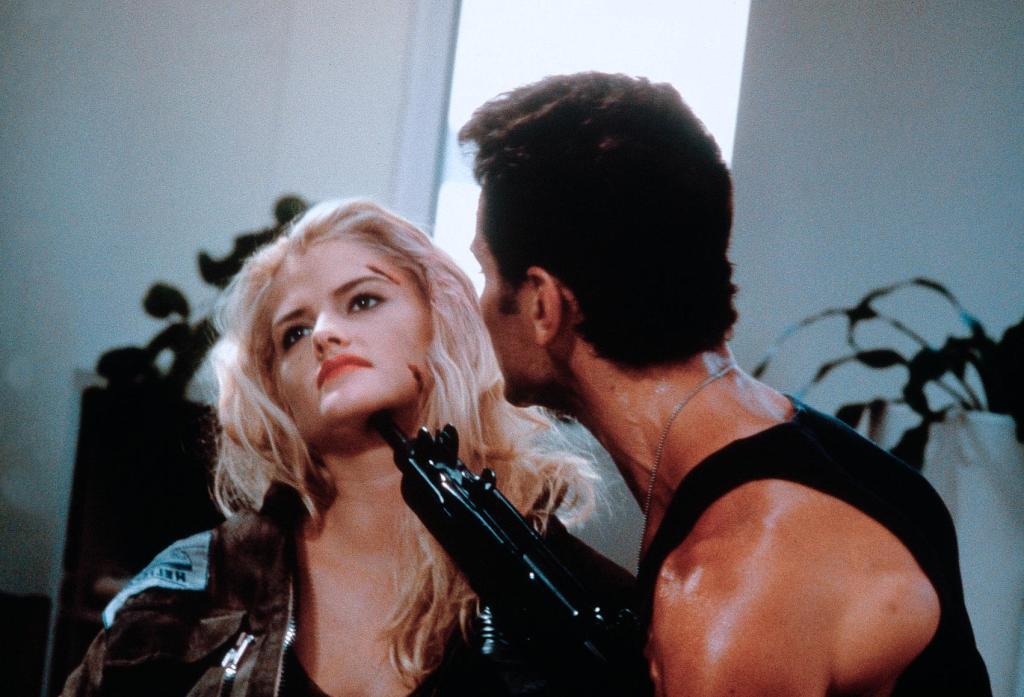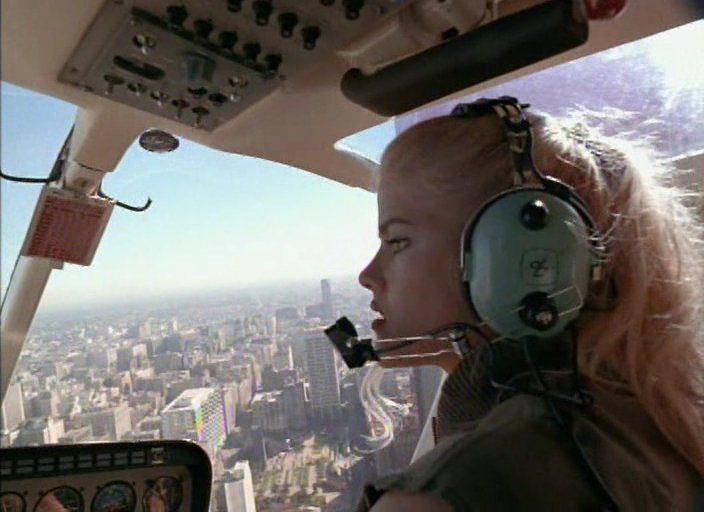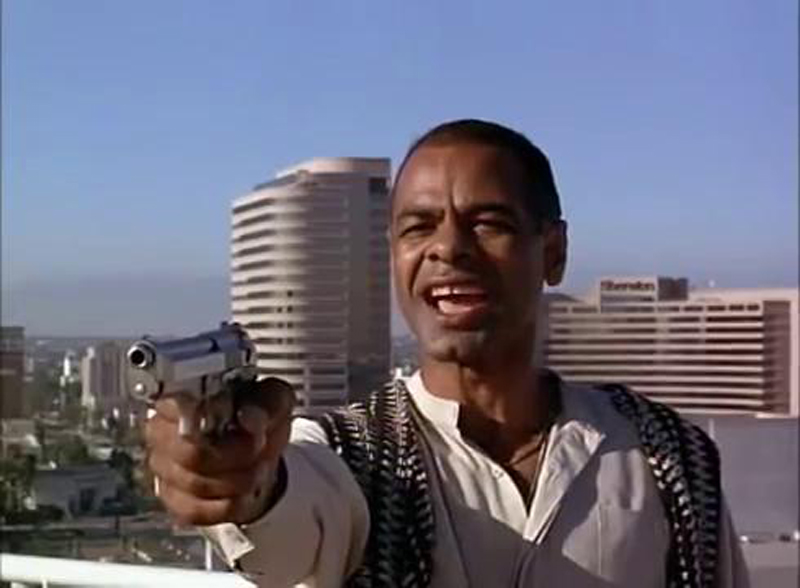Skyscraper: Anna Nicole Smith’s Low-Budget Die Hard Clone
Long before The Rock's Skyscraper, there was Anna Nicole Smith's 1996 action-thriller, which owes a considerable debt to Die Hard...
A high-tech building beset by villains and machine gun fire. A hero dangling from a wire dozens of storeys off the ground. Hostages. Explosions. More machine gun fire. Those are some of the sights that await us in Skyscraper, the latest action-thriller opus from Dwayne Johnson – arguably the closest thing the 21st century has to a star of Arnold Schwarzenegger’s stature.
Sure, comparisons with the ’80s classic Die Hard are inevitable, but like most of Johnson’s best films, including the latter Fast films, San Andreas and the surprise hit, Jumanji, there’s the sense that Johnson’s in on the joke. He clearly loves being an action star, and the enjoyment’s infectious. In the first trailer for Skyscraper, the big takeaway image is of Johnson making a leap from a gantry suspended about 800 kilometres in the air to a nearby building. It’s a jump so vast that no human being could possibly survive it.
To date, the trailer has had around 12 million hits on YouTube. Say what you like about the believability of Dwayne Johnson’s stunts – the guy certainly knows his audience.
So too, it seemed, did the makers of another film called Skyscraper, this one from the distant year of 1996. Back then, we were in the midst of a Die Hard clone epidemic – movies that attempted to copy its single-location thriller template to varying degrees of success. Steven Seagal scored a decent hit with Under Siege (the one on a warship) in 1992. Sylvester Stallone broke a run of box office disappointments with Cliffhanger (the one on a mountain) in 1993. Keanu Reeves bulked up for the surprise hit, Speed (the one on a bus) in 1994.
Skyscraper was surely the most brazen – and sauciest – Die Hard clone to emerge from that whole strange period. For one thing, it doesn’t even attempt to put the “one unprepared hero versus the bad guys” concept in a new setting; instead, it basically lifts the entire plot wholesale from Bruce Willis’s 1988 hit, and even attempts to restage some of its major action set-pieces.
Skyscraper distinguishes itself with two major changes: first, it tries to remake Die Hard with roughly the same budget as an episode of the old TV soap, Dynasty. Second, it asks former Playboy model Anna Nicole Smith to pick up a gun and become a high-kicking ’90s action heroine.

By the mid-90s, Smith had already made the jump to the big screen with appearances in such films as the Coen brothers’ The Hudsucker Proxy and comedy sequel, Naked Gun 33⅓. Skyscraper, meanwhile, asked Smith to shoulder a whole movie on her own – a potentially daunting prospect, but not an entirely improbable one, given that Smith had co-starred in the action sequel To The Limit a year earlier – a film also directed by Skyscraper‘s Raymond Martino. Around the same time, another actress and former Playboy model, Pamela Anderson, was also making action movies with the likes of Raw Justice (1994) and Barb Wire (1996).
The advantage Anderson had, though, was that her movies tended to pair her with some not entirely terrible production values and more established actors as co-stars – Raw Justice also featured Stacy Keach, while the $9 million comic book adaptation Barb Wire also had Xander Berkeley and Udo Kier to lend support.
Poor Anna Nicole Smith doesn’t have any of this in Skyscraper. Aside from Smith, the biggest star in is Richard Steinmetz, best known from US soap operas, Brank Cikatic, a former kickboxer from Croatia, and Charles M. Huber as the main villain – better known these days as a politician in his native Germany. Instead, Skyscraper exploits the presence of its leading lady in every way it can – and a quick glance at the critical notices on the DVD cover give you an idea of the level of its ambition: “Ms. Smith gets her kit off”, one line reads. “Lads won’t be disappointed,” enthuses another. A third simply shrieks, “Bra busting!”
Unsurprisingly, the movie itself isn’t exactly Citizen Kane. Smith plays one Carrie Wink, a helicopter pilot who specialises in shuttling posh businessmen from the roof of one building to another. When she’s not working her aerial taxi shift, Carrie takes improbably long showers and engages in passionate nude clinches with her husband, a sweaty cop named Gordon. These extended scenes are clearly meant as a sop to fans of Smith’s glamour modelling period, though there’s something oddly disturbing about the way director Raymond Martino shoots his moments of passion – there’s a slow, almost bio-mechanical air to them, like the ending of Brian Yuzna’s infamous cult horror, Society.

Meanwhile, the plot: verbose bad guy Fairfax (Huber) wants to get his hands on some form of super-weapon, and he’s making deals with all kinds of other shady types across Los Angeles to collect its four constituent parts. What is this super-weapon? We’re never told, but it’s small enough to fit in a brief case and it is, according to Fairfax, “A small price to pay for infinite power!”
All of this leads to the Die Hard bit of the story. For reasons unknown, Fairfax and his army of goons take over a high-tech Los Angeles building, lock all the doors and hold a bunch of office workers at gunpoint. Carrie Wink, who’d flown Fairfax to the roof of the building in the first place, heads downstairs to use the phone and becomes embroiled in the terrorist plot.
With her Texan accent and immaculate fingernails, Carrie is certainly an unlikely action hero, and the film could’ve played with this in the same way that Die hard portrayed John McClane as a mortal, average cop before he started gunning down all the bad guys. Instead, Carrie’s not so much average and relatable as straight-up clumsy. By our estimation, the heroine manages to inadvertently cause the deaths of at least three innocent people, and worse, she doesn’t even seem to realise she’s partly responsible.
In one scene, Carrie hides in a lift, and for some reason, drags a middle-aged office drone into the metal box with her. A bad guy tracks her down, but when the lift doors open, Carrie’s already snuck through the hatch that all movie lifts have in the ceiling. This leaves the middle-aged office drone stuck in the lift on his own as the villain opens fire. In the next scene, Carrie seems completely unfazed by the innocent man’s death; she just sits down and thinks back to an old memory of shooting bottles with a .48 Magnum and then making love to her husband on a picnic blanket.
It’s also established that a female office worker, who coincidentally has big blonde hair just like Carrie, has brought her son into work for the day. The boy rides around on a plastic three-wheeled bike like Danny Lloyd in The Shining, even when a bad guy marches into the office, mistakes his mother for Anna Nicole Smith, and shoots her three times in the back. (More on this horrifying incident later.)

When Carrie does finally start offing the bad guys, it’s probably fair to say that Smith isn’t exactly Ronda Rousey. To be fair to Smith, god rest her, the laughable shoddiness of her fight scenes are as much to do with the dreadful editing and choreography; when Smith kicks or punches someone, the framing and cutting makes her look as though she’s in a different county from her opponent.
Skyscraper‘s stunts, on the other hand, are really something else. In the first half an hour, there’s a massive battle between Fairfax’s villains and a bunch of other guys in black suits – they’re among the various people who’ve shown up in LA to sell the secret weapon in a briefcase. What follows is a genuinely dangerous-looking exchange that involves rocket-propelled grenades being fired into an alleyway, machine gun fire, and cars reversing through great curtains of flame.
The stunts are so impressive and well-handled that it almost looks like they came from another film; it’s little surprise that, when the end credits roll, stunt coordinator Cole McKay is mentioned before everybody else. If there’s one thing about Skyscraper that had our jaws dropping for the right reasons, it was the stunts. In a later scene, a bunch of fire fighters are climbing along the ladder mounted atop a fire truck when they’re hit by another rocket-propelled grenade (there are a lot of RPGs in this movie). Thinking about it, Skyscraper‘s overall tactic, when the action starts to sag, is to simply throw a stunt person out of a window or set a man on fire.
This leads us to one of the most obvious lifts from Die Hard: a sequence where Carrie, pursued by a man carrying a machine gun, throws herself off the top of the skyscraper with a cable tied around her waist, then smashes her way through a window onto a lower floor, feet-first. Again, the stunt-work is really impressive – what lets the sequence down is the dreadful editing, which leaves the heroine dangling in mid-air for such a long time that the sense of danger quickly ebbs.
Other scenes from Die Hard are also staged on a lower budget. Skyscraper can’t afford to have Carrie make an improvised bomb out of a computer monitor and an office chair, so she gets the villains’ attention by setting fire to some waste paper bins instead. (In a magnificent final touch, one bin fire is put out by a disembodied hand holding a fire extinguisher.)
What Skyscraper lacks in tension it soon makes up for with its comically awful performances. The rank-and-file villains are from the similar school of casting as the ones in Die Hard – for some reason, low-ranking goons in 80s and 90s movies always took incredible care of their hair. Not a split end amongst them. Fairfax, by contrast, is completely off the wall: Charles M Huber clearly isn’t here for the acting, and he spends much of the film mangling lines from Shakespeare, shooting people, screaming and then breaking into massive, freakish grin. As a big screen performance, it borders on the avant-garde.

Elsewhere, you’ll find some brilliantly awful accents (“I won’t say a verd without my attorney being present!”), terrible lines of dialogue (“Well, excuse me for still believing in Sunday walks in the park and little babies!”) and wonderful expressions of pain (“Ooh, mah leg!”).
Less enjoyable are the leering and inordinately lengthy sequences that focus on Anna Nicole Smith’s physique, which are more disquieting than anything else. But as one of the most blatant and laughably uneven Die Hard clones ever made, Skyscraper is seldom less than fascinating – especially in the moments where the filmmakers appear to have thrown the script over their shoulder and made stuff up on the fly.
Remember the kid from earlier on, the one riding around on his little plastic bike? One of the film’s recurring gags (or we treated it like a gag) is that Carrie keeps telling him that he’ll be seeing his mommy real soon. The trouble is, we saw his mother being gunned down in cold blood moments earlier, so we were just waiting for someone to break the bad news to the poor boy. But then, right there in the final reel, a body’s wheeled into the back of an ambulance, covered in bandages, strapped to a gurney and seemingly dead.
“See?” Carrie says to the boy, bundling him in the back of the ambulance with the body. “I told you everything would be alright.”
Now, assuming the mother is indeed alive, we can’t imagine why the director didn’t include a close shot of the woman sitting up on the gurney, smiling and reassuring her son. Instead, she just lies there, bandaged up and completely unrecognisable. For all we know, the original actress walked off the film, leaving the filmmakers without anyone to play the boy’s mother. Or alternatively, it’s all a grim joke – the mother really is dead, and nobody, not even the paramedics, bothered to correct Carrie or the kid.
As a final comic flourish, a police chief enters stage left and thrusts a black puppy in the boy’s hands. Unless we blinked, the puppy didn’t appear in any other scene of the film. It’s never explained where the police chief got the puppy.
Skyscraper went straight to video in 1996, and promptly made its way to bottom shelves and bargain bins. Anna Nicole Smith made other TV and film appearances of various kinds before her sad death in 2007, but her career as a gun-waving action star concluded here. Still, as a time capsule from a bygone age of action-thrillers, Skyscraper deserves at least an acknowledgement. Dwayne Johnson’s own Skyscraper will almost certainly have better effects, acting and editing, but we doubt it’ll have lines as golden as these:
“I designed this building to withstand paramilitary attacks.”
“We need a place to hide. Do you have a place to hide?”
“Lucky for me you don’t fly like you make love or I’d be in trouble.”
Carrie Wink, you shall be missed.